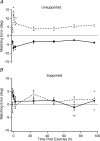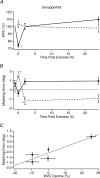Human forearm position sense after fatigue of elbow flexor muscles
- PMID: 15181165
- PMCID: PMC1664958
- DOI: 10.1113/jphysiol.2004.062703
Human forearm position sense after fatigue of elbow flexor muscles
Abstract
After a period of eccentric exercise of elbow flexor muscles of one arm in young, adult human subjects, muscles became fatigued and damaged. Damage indicators were a fall in force, change in resting elbow angle and delayed onset of soreness. After the exercise, subjects were asked to match the forearm angle of one arm, whose position was set by the experimenter, with their other arm. Subjects matched the position of the unsupported reference arm, when this was unexercised, with a significantly more flexed position in their exercised indicator arm. Errors were in the opposite direction when the reference arm was exercised. The size of the errors correlated with the drop in force. Less consistent errors were observed when the reference arm was supported. A similar pattern of errors was seen after concentric exercise, which does not produce muscle damage. The data suggested that subjects were using as a position cue the perceived effort required to maintain a given forearm angle against the force of gravity. The fall in force from fatigue after exercise meant more effort was required to maintain a given position. That led to matching errors between the exercised and unexercised arms. It was concluded that while a role for muscle spindles in kinaesthesia cannot be excluded, detailed information about static limb position can be derived from the effort required to support the limb against the force of gravity.
Figures






References
-
- Brockett C, Warren N, Gregory JE, Morgan DL, Proske U. A comparison of the effects of concentric versus eccentric exercise on force and position sense at the human elbow joint. Brain Res. 1997;771:251–258. - PubMed
-
- Gandevia SC. Kinesthesia: roles for afferent signals and motor commands. In: Rowell LB, Shepherd J T, editors. Handbook of Physiology. New York: Oxford University Press; 1996. pp. 128–172. section 12, Exercise: Regulation and Integration of Multiple Systems,
-
- Gandevia SC. Spinal and supraspinal factors in human muscle fatigue. Physiol Rev. 2001;81:1725–1789. - PubMed
Publication types
MeSH terms
LinkOut - more resources
Full Text Sources
Medical

